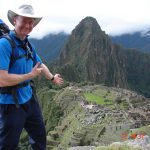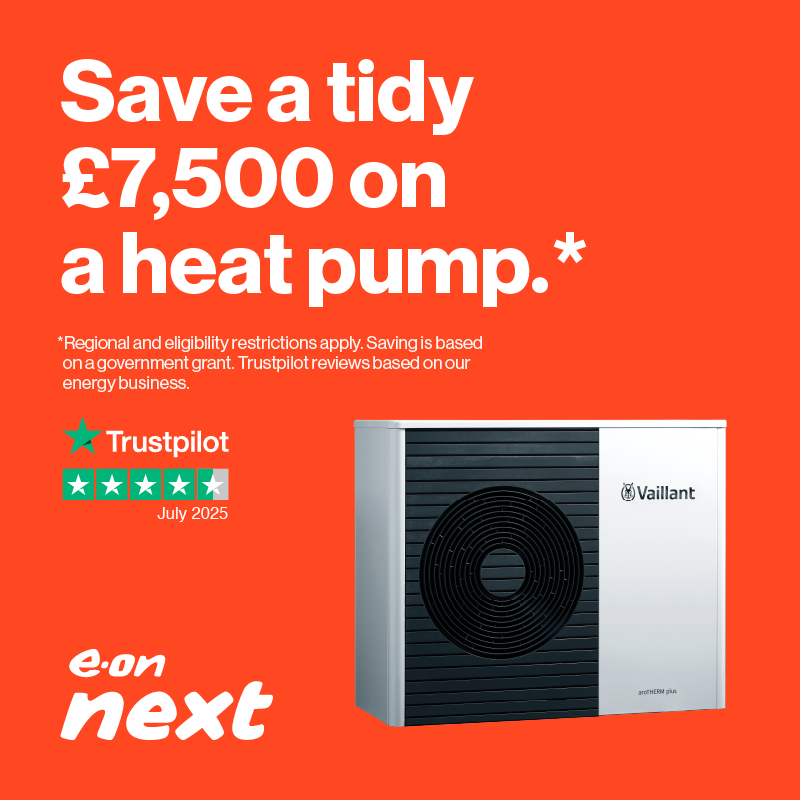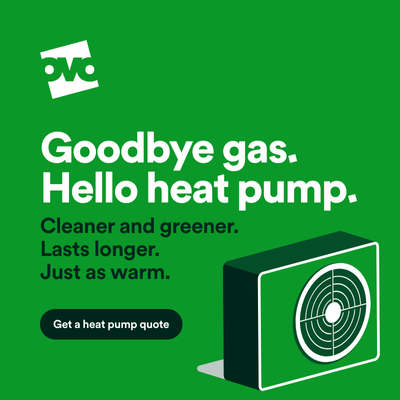Posted by: @kev-mI've limited the max temp to 48; I might drop that to 43, which is the highest setting when I'm running WC. I'm not that bothered about the house heating up quickly, especially as ours is set to 21. AA can be a bit too aggressive for me.
I might try the two step approach like you some time
Yes, I’m finding out AA does seem to be quite aggressive even though it’s set to normal. Perhaps the developers could have considered an eco setting or a specific soft start.
Is the max 48c you refer to the setting on your WCcurve or is there something else you can adjust?
Also, do you know if the +5 and -5 setting on the AA setup adds to the overrun room temp or does it add to the flow temp setting on the WCcurve? I’m unclear.
I might also look at weather compensation again for when it’s milder with a lower flow temp setting since I think we get a bit of cycling and our COP drops a bit on milder days when I was hoping for some gains.
Posted by: @sunandairPosted by: @kev-mI've limited the max temp to 48; I might drop that to 43, which is the highest setting when I'm running WC. I'm not that bothered about the house heating up quickly, especially as ours is set to 21. AA can be a bit too aggressive for me.
I might try the two step approach like you some time
Yes, I’m finding out AA does seem to be quite aggressive even though it’s set to normal. Perhaps the developers could have considered an eco setting or a specific soft start.
Is the max 48c you refer to the setting on your WCcurve or is there something else you can adjust?
Also, do you know if the +5 and -5 setting on the AA setup adds to the overrun room temp or does it add to the flow temp setting on the WCcurve? I’m unclear.
I might also look at weather compensation again for when it’s milder with a lower flow temp setting since I think we get a bit of cycling and our COP drops a bit on milder days when I was hoping for some gains.
The 48 refers to the max and min settings in the same menu as the +-5 you refer to.
What that (the +-5) does I'm not sure. It says it varies around the 'target flow temperature' but I'm not sure what that is when you'e in AA mode. I think you said before it was the current WC target. I said I thought it might not be but it could just about if I allow a bit of error in the values I see in Melcloud. It can't be the room temp because even 5 degrees would be far too much. I think I read somewhere that AA allowed +-1 deg around its room target. That fits with what I observe; I see 20-22 when my target is 21.
Anyway I've changed it to 43 so let's see what happens.
Posted by: @kev-mWhat that (the +-5) does I'm not sure. It says it varies around the 'target flow temperature' but I'm not sure what that is when you'e in AA mode. I think you said before it was the current WC target. I said I thought it might not be but it could just about if I allow a bit of error in the values I see in Melcloud.
I think I have a firm handle on the +-5 setting. As you say it's not easy to know what the target LWT is at any point in time as it's changing all the time, but the +-5 relates to an overshoot and undershoot of that target (i.e. intended to address excessive cycling as it allows a much longer cycle). Attached is a chart where I was trialing +3 and -9 a few weeks ago (target is assumed but it did match with my curve settings at the time). If I'm right, if you are running at the default of +5 you are going to be overshooting by 5c. I'm sticking with +3 to prevent too much overshoot.
[Edit] Else turn the function OFF and see what happens. If cycling is not an issue, and it is ON of course.
sorry there's so much going on here, yes it was you that said this and not @sunandair. 🙂
So hopefully I'm allowing an overshoot of 5 but limited to my top WC target. I'm assuming that the overall maximum overrides the WC + allowed overshoot, but we'll see...
Posted by: @kev-msorry there's so much going on here, yes it was you that said this and not @sunandair. 🙂
So hopefully I'm allowing an overshoot of 5 but limited to my top WC target. I'm assuming that the overall maximum overrides the WC + allowed overshoot, but we'll see...
I'm not sure who said what either lol.
I have edit the above post, but just to highlight that +-5 setting can be turned off. If you feel it's getting in the way, might be worth turning it off.
Posted by: @kev-mPosted by: @sunandairPosted by: @kev-mI've limited the max temp to 48; I might drop that to 43, which is the highest setting when I'm running WC. I'm not that bothered about the house heating up quickly, especially as ours is set to 21. AA can be a bit too aggressive for me.
I might try the two step approach like you some time
Yes, I’m finding out AA does seem to be quite aggressive even though it’s set to normal. Perhaps the developers could have considered an eco setting or a specific soft start.
Is the max 48c you refer to the setting on your WCcurve or is there something else you can adjust?
Also, do you know if the +5 and -5 setting on the AA setup adds to the overrun room temp or does it add to the flow temp setting on the WCcurve? I’m unclear.
I might also look at weather compensation again for when it’s milder with a lower flow temp setting since I think we get a bit of cycling and our COP drops a bit on milder days when I was hoping for some gains.
The 48 refers to the max and min settings in the same menu as the +-5 you refer to.
What that (the +-5) does I'm not sure. It says it varies around the 'target flow temperature' but I'm not sure what that is when you'e in AA mode. I think you said before it was the current WC target. I said I thought it might not be but it could just about if I allow a bit of error in the values I see in Melcloud. It can't be the room temp because even 5 degrees would be far too much. I think I read somewhere that AA allowed +-1 deg around its room target. That fits with what I observe; I see 20-22 when my target is 21.
Anyway I've changed it to 43 so let's see what happens.
The way that I interpret the +5 to -9 thermo diff setting, is that it could possibly become active in milder weather conditions.
The calculated LWT is normally maintained by varying the compressor speed, but when the compressor reaches its minimum operating speed it can no longer control the LWT. In this situation, it is quite possibly that the LWT will increase above the calculated value, so the FTC controller stops the compressor when the LWT reaches this upper limit. With the compressor stopped the LWT will start to fall, and the FTC controller restarts the compressor when the LWT reaches the lower limit. By having a large difference between the upper and lower limit settings, it should extend the time period between the compressor being switched off and then restarted. i.e. reduced cycling.
Once the loading on the heat pump increases, to the level where the compressor is no longer operating at minimum speed, the system will once more operate in normal AA mode.
Posted by: @kev-msorry there's so much going on here, yes it was you that said this and not @sunandair. 🙂
So hopefully I'm allowing an overshoot of 5 but limited to my top WC target. I'm assuming that the overall maximum overrides the WC + allowed overshoot, but we'll see...
I think that you should find that having an upper limit of +2 or +5 will make no difference to the amount of electrical energy being used by the heat pump at that instant in time, since it will probably be running at minimum operating speed for the overshoot to occur in the first place.
Having a wide upper and lower limit difference should just mean that the heat pump runs for a little longer time period when it is running, but then is off for a longer time period when it is stopped, which may use slightly less electrical energy, but may cause a larger variation in indoor air temperature.
Posted by: @derek-mPosted by: @kev-msorry there's so much going on here, yes it was you that said this and not @sunandair. 🙂
So hopefully I'm allowing an overshoot of 5 but limited to my top WC target. I'm assuming that the overall maximum overrides the WC + allowed overshoot, but we'll see...
I think that you should find that having an upper limit of +2 or +5 will make no difference to the amount of electrical energy being used by the heat pump at that instant in time, since it will probably be running at minimum operating speed for the overshoot to occur in the first place.
Having a wide upper and lower limit difference should just mean that the heat pump runs for a little longer time period when it is running, but then is off for a longer time period when it is stopped, which may use slightly less electrical energy, but may cause a larger variation in indoor air temperature.
Agreed. I've settled on +3 largely for that reason, the comfort factor. At +5 I could almost 'feel' a +5 overshoot (some rooms feeling a tad warm). I do like how ASHP's can deliver that background warmth that should not be noticed.
Posted by: @derek-mPosted by: @kev-msorry there's so much going on here, yes it was you that said this and not @sunandair. 🙂
So hopefully I'm allowing an overshoot of 5 but limited to my top WC target. I'm assuming that the overall maximum overrides the WC + allowed overshoot, but we'll see...
I think that you should find that having an upper limit of +2 or +5 will make no difference to the amount of electrical energy being used by the heat pump at that instant in time, since it will probably be running at minimum operating speed for the overshoot to occur in the first place.
Having a wide upper and lower limit difference should just mean that the heat pump runs for a little longer time period when it is running, but then is off for a longer time period when it is stopped, which may use slightly less electrical energy, but may cause a larger variation in indoor air temperature.
It will but when running on AA the variation is 'capped' by the room temperature. But thinking about it, if you have small allowed overshoot, or none at all (and if the overshoot does refer to the WC value) then AA won't be doing much that a dumb thermostat can't.
I'm
Posted by: @gotaashpIf I'm right, if you are running at the default of +5 you are going to be overshooting by 5c. I'm sticking with +3 to prevent too much overshoot.
I was hoping it might be a bit more subtle than that 😢
I was hoping the +-5 would be a mark up on the WCcurve set point. So Adaptive could set a hotter or cooler flow temp and therefore speed up or slow down the approach to the target room temperature. (And when close to set room temp revert back to the actual compensation curve)
I guess I’m expecting too much
I am still set at + - 5.... one thing ive noticed I only overshoot room target by 0.5c and occasionally 1c
Posted by: @kev-mPosted by: @derek-mPosted by: @kev-msorry there's so much going on here, yes it was you that said this and not @sunandair. 🙂
So hopefully I'm allowing an overshoot of 5 but limited to my top WC target. I'm assuming that the overall maximum overrides the WC + allowed overshoot, but we'll see...
I think that you should find that having an upper limit of +2 or +5 will make no difference to the amount of electrical energy being used by the heat pump at that instant in time, since it will probably be running at minimum operating speed for the overshoot to occur in the first place.
Having a wide upper and lower limit difference should just mean that the heat pump runs for a little longer time period when it is running, but then is off for a longer time period when it is stopped, which may use slightly less electrical energy, but may cause a larger variation in indoor air temperature.
It will but when running on AA the variation is 'capped' by the room temperature. But thinking about it, if you have small allowed overshoot, or none at all (and if the overshoot does refer to the WC value) then AA won't be doing much that a dumb thermostat can't.
I'm
When operating in AA mode, and the compressor has been pulled back to minimum operating speed, the FTC controller has basically 'lost' control. As the LWT increases above the calculated value, the normally action would be to reduce the compressor speed, but this is no longer possible. The system therefore reverts to a type of on - off control, that is designed to minimise cycling. The LWT is allowed to increase until it reaches the upper temperature limit, at which point the compressor is stopped. The compressor does not restart again until the LWT falls to the lower temperature limit, which will hopefully be a lengthy period of time.
Whilst the room temperature will vary due to the above on - off operation, the variation should be within acceptable limits.
I thought I'd plot compressor frequency on a typical AA cycle to try and understand what's going on under the hood (rather annoying that frequency isn't chartable in Melcloud, so I've had to take manual readings every 5 mins). From this set of data it appears to be soft starting - starting at a low frequency and ramping up. There is no apparent effort to back off (although I guess the 52 number may be the minimum it want's to run at after soft starting from a lower number). Once again the target temp is an informed assumption on my part.
Note: frequency numbers added at the bottom of the chart. I'm still running thermo diff adjust values of +3 and -9.
- 26 Forums
- 2,342 Topics
- 53 K Posts
- 262 Online
- 6,000 Members
Join Us!
Worth Watching
Latest Posts
-
Heat Pump Performance Analysis Web App using Modbus Data
TL;DR: therm turns raw heat-pump history into structure...
By redzer_irl , 5 hours ago
-

RE: The good, the bad and the not that great – my heat pump installation
@cathoderay the guy I spoke to on the phone seemed very...
By Burtis , 6 hours ago
-
RE: A Smarter Smart Controller from Homely?
Talking of a smarter homely, I was getting too frequent...
By Papahuhu , 7 hours ago
-
RE: Setback savings - fact or fiction?
interestingly that’s not what I see, here is the same f...
By Adrian , 7 hours ago
-

RE: Homely for Daikin Altherma 3 - Petersfield Area
Welcome to the forums @russ. We have a massive thread...
By Mars , 8 hours ago
-
RE: Configuration issues with 10kW Midea R32 heat pump
Sorry that was a screenshot of @curlyKatie - mine has...
By SteveT , 9 hours ago
-
Different dT on each radiator?
All supplier surveys I've had, as well as tools like He...
By medwardz , 10 hours ago
-
RE: British Gas vs Octopus Energy vs Heat Geek vs EDF vs Aira vs OVO vs EON.Next vs Boxt
I get the impression that that comment "they don't comm...
By JamesPa , 12 hours ago
-

@majordennisbloodnok Just in case there are variations ...
By Toodles , 13 hours ago
-

RE: Latest NIBE model has known defect and no solution
@kings I’m glad I could help. NIBE are taking this very...
By Mars , 15 hours ago
-
RE: Octopus Cosy Heat Pump Owners & Discussion Thread
@jamespa yes, I'm under no illusions but in some respec...
By AndrewJ , 16 hours ago
-
RE: Poll for Time of Use, tariffs, technology
@majordennisbloodnok thanks. Unfortunately i can't upd...
By Tim441 , 19 hours ago
-
RE: Electricity price predictions
It seems the end of cfd payments is in sight, even if a...
By Batpred , 21 hours ago
-
-
@pie_eater Yes, I installed Homely to a Daikin heat pum...
By gery , 1 day ago
-
RE: Havenwise App Help & Forum Support – Get the Most from Your Heat Pump
@davidalgarve Potentially stupid question, but are you ...
By Sheriff Fatman , 1 day ago
-
RE: What a Bad Heat Pump Installation Looks Like
Spot on, for relatively little money, an air of ready "...
By Batpred , 1 day ago
-
RE: Replacing my 18 month old Hitachi Yutaki ASHP
@trebor12345 Ok that makes more sense and leads is i...
By JamesPa , 2 days ago
-
-

RE: Home energy storage & battery register
Now the proud owner of: 4.1Kw peak Aiko Neostar solar...
By TechnoGeek , 2 days ago







